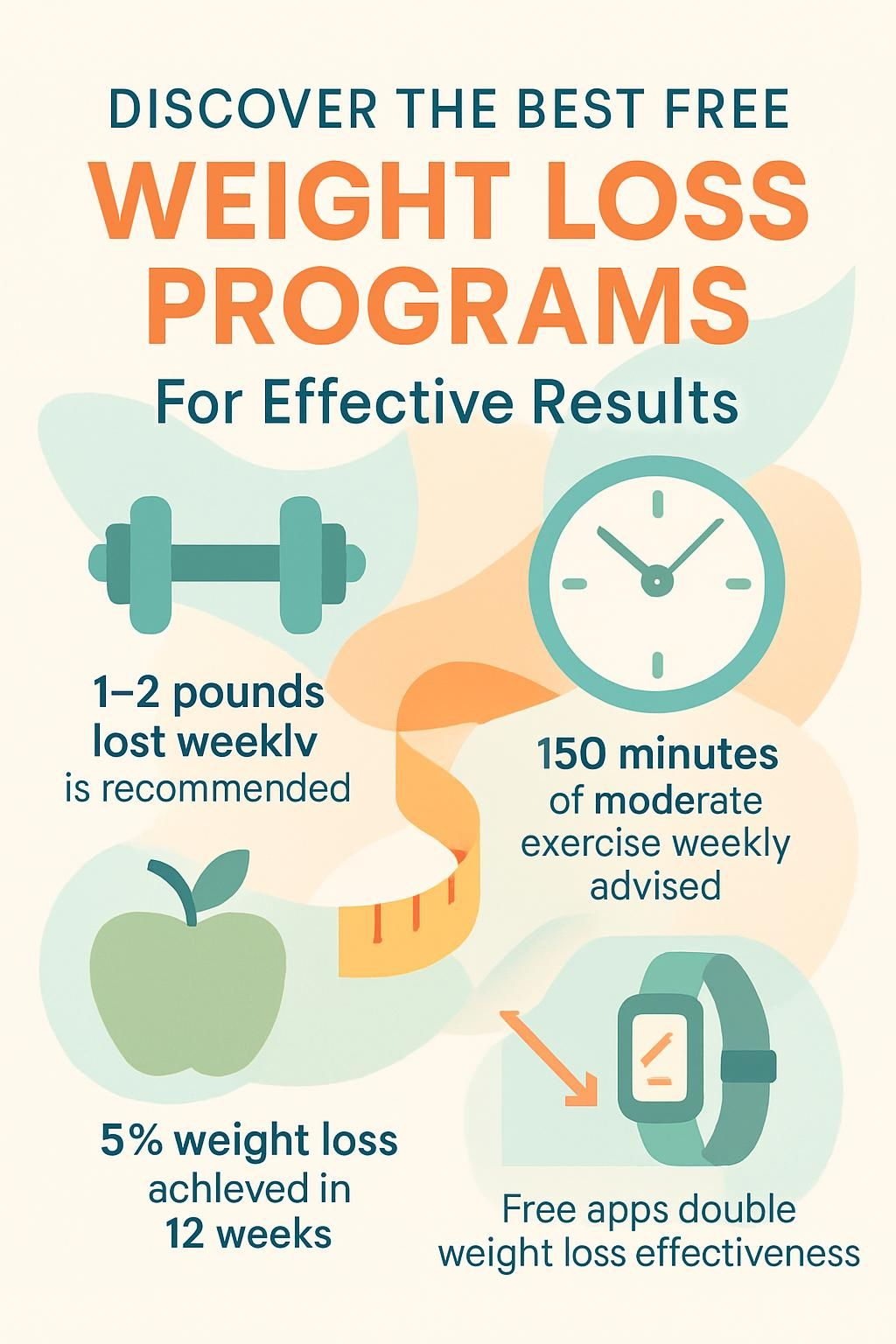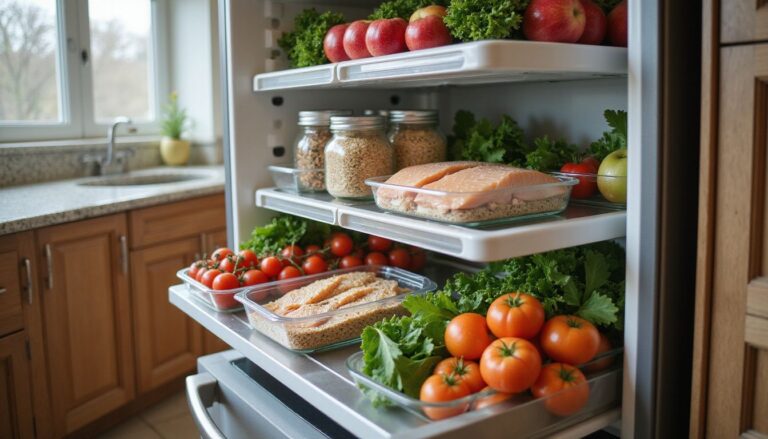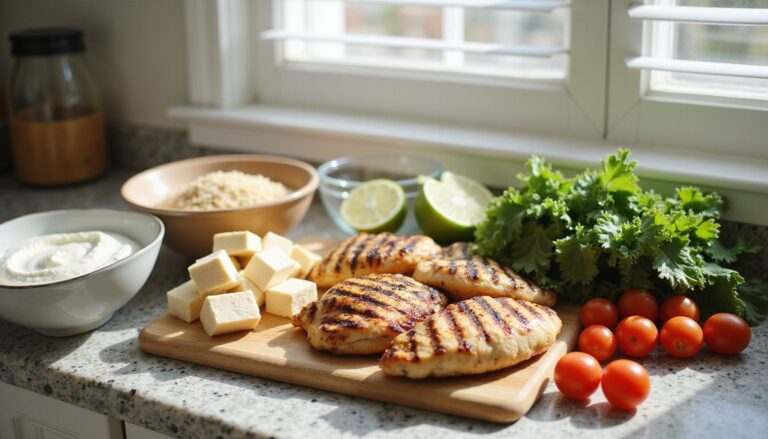Discover The Best Free Weight Loss Programs For Effective Results
Our Nutrition Assistant AI Suite will transform your body. You will lose fat, get toned, and build muscle. Gain confidence and optimal health.
Many people want to lose weight but worry about cost. Free weight loss programs give you proven tools, simple plans, and steady support. They help you shed pounds, keep them off, and protect your budget.
This guide highlights the best free resources, including free apps, step-by-step weight loss plans, and community support. Use them to stay on track and reach your weight loss goal without paying extra.
Key Takeaways
- Free weight loss programs such as the NHS Weight Loss App, MyFitnessPal, and Lose It! use research-based tracking, meal planners, and community support to drive results.
- People who track meals daily with free apps lost nearly twice as much weight as non-trackers (Burke et al., 2019).
- Community programs like EFL Trust FIT FANS helped participants lose about 5% of starting weight in 12 weeks (Public Health England, 2020).
- Experts suggest realistic targets of 1–2 pounds per week and at least 150 minutes of moderate exercise for sustainable progress (CDC guidelines).
- Local authority services, NHS calculators, and group challenges offer free tools and motivation, making healthy weight loss accessible without premium plans.

Why Are Free Weight Loss Programs Effective?

Free plans work because they use structure, daily tracking, and social support. These tools help you change habits, make better choices, and keep going when life gets busy.
Research shows you can see strong results using simple, repeatable steps. Clear goals and regular feedback make healthy routines easier to follow over time.
Who Can Benefit from Free Weight Loss Programs?
People from many backgrounds can benefit from a cost-free weight loss program. If you want expert guidance without fees, these options fit different life stages and schedules.
Those managing obesity-related conditions like type 2 diabetes or heart disease often find structured support helpful. Students on tight budgets or busy parents can use the NHS Weight Loss App or MyFitnessPal to track calories and set realistic goals.
You may want a diet plan that builds healthy eating habits and supports long-term weight management. Free options often include meal plans, fitness tracking apps, group challenges, and simple lessons on nutrition and physical activity from trusted sources like Mayo Clinic and the Centers for Disease Control and Prevention.
I joined a local authority program after my doctor advised me to lower my body weight. That free, community-based option gave me practical tips and kept my costs low.
A good weight-loss program should match your lifestyle so you can lose weight safely but also maintain it over time.
How Do Free Programs Build Sustainable Habits?
Free weight management programs focus on daily behavior change. Apps like MyFitnessPal or the NHS Weight Loss Plan provide easy trackers for meals, activity, and sleep.
These tools encourage realistic goals, steady weight tracking, and a healthy diet. Consistent meal logging helps you spot patterns that affect cravings and energy.
Many programs send reminders to move and offer tips like choosing whole foods and low-calorie snacks. Community features add accountability through group challenges, forums, or one-to-one support.
People who engage with social support often lose more weight and keep it off longer. Free programs also supply recipes, health education, and simple fitness tools, which makes a healthy weight easier to maintain.
This approach fits your daily routine and raises your chances of reaching your goal weight.
What Cost-Free Resources Do They Use for Success?
Many effective programs use free digital tools to build a personalized weight loss plan. The NHS Weight Loss App offers a 12-week structure, daily planners, and helpful reminders at no cost.
Trackers for physical activity and calorie intake support clear, realistic goals. The free version of MyFitnessPal lets you log meals, count calories, and monitor progress with simple charts.
Online communities such as SparkPeople provide forums, food trackers, and motivation without fees. You can join public challenges or group chats for accountability.
Local health authorities in the United Kingdom often provide group exercise, educational materials, or body mass index calculators at no cost. Using these free apps and community resources helped me stick with exercise and meal planning without paying for pricey plans.
What Are the Best Free Weight Loss Programs to Try in 2023?
Several free programs can help you lose weight and keep it off in 2023. The NHS Weight Loss Plan, available in the UK, offers a structured 12-week guide to healthy weight loss.
The plan includes weekly check-ins, goal setting tools, and simple advice on healthy eating and physical activity. MyFitnessPal and Lose It! both offer strong free versions.
These apps let you log meals, track calories by food group, and see progress in easy charts. You get meal ideas, barcode scanners, community support, and movement reminders.
EFL Trust FIT FANS brings sports fans together at local stadiums for group sessions and coaching. You learn balanced eating and steady fitness habits, plus you get motivation from fellow fans.
Many local authority programs also provide group meetings or one-to-one guidance at no cost. Dietitians or health care providers help set targets like losing 1 to 2 pounds per week, which aligns with clinical nutrition guidance.
I used the free version of MyFitnessPal last summer after my doctor suggested it. Tracking protein made me more aware of which foods affected my body weight each day. SparkPeople also offers motivation tools, healthy recipes, and gamified features that make progress feel rewarding.
“Tracking your food every day keeps you accountable and shows how small changes make a real difference.”
NHS Weight Loss Plan Overview
The NHS Weight Loss Plan gives a structured, trustworthy path built on evidence. Below are the features that make this free option effective for many people.
What Are the Key Features of the 12-Week NHS Plan?
The 12-Week NHS Weight Loss Plan promotes steady, healthy change with clear steps and practical tools.
- Weekly guidance shows you how to build a plan for healthy eating and regular activity.
- Meal plans reduce processed foods and added sugars, supporting balanced energy throughout the day.
- Daily tasks prompt food logging, movement tracking, and realistic goal setting for effective results.
- The NHS app provides reminders, privacy controls, and tips on your phone so progress fits your routine.
- Printable trackers help you record body weight, meals, and steps or calories burned.
- Weekly lessons cover portion control, nutrition basics, interval workouts, and risks tied to excess weight, like heart attack.
- Healthy recipes offer simple ideas that support your plan without costly specialty foods.
- Online community features build accountability through shared experiences and steady check-ins.
- Advice follows National Health Service standards, which supports a safe, successful weight-loss program.
Daily meal logging in the NHS app helped me stay mindful during the first month. Tracking steps nudged me to move more until it became a steady habit that supported weight loss and fitness.
What Are the Advantages of the NHS Weight Loss App?
The NHS Weight Loss App is free, so you get solid support with zero fees. It offers a 12-week plan, healthy meal ideas, and daily tips for healthy weight loss.
Built-in tools track food intake and physical activity. Seeing patterns makes it easier to adjust your habits.
Clear prompts remind you to log meals and complete simple challenges. I tried the app last spring after reading about its design on the NHS site. Extra steps each day added up, and weekly check-ins kept me motivated. Plans with similar features often cost money elsewhere, which makes this option stand out in 2023.
EFL Trust FIT FANS Program Details
The EFL Trust FIT FANS program blends coaching with team spirit. If you enjoy sports, this approach can make change feel more fun and doable.
How Does the Program Work for Sports Fans?
FIT FANS brings weight loss support into stadium settings, which feels exciting for many football fans. You attend weekly sessions at your local club. Coaches use team culture to teach healthy habits and lead guided activities.
Progress is checked at the start, mid-point, and the end. Sessions cover nutrition, exercise, motivation, and how to make changes that last. A 2020 Public Health England report showed around 5 percent average weight loss over 12 weeks.
Many fans stay engaged because the group support feels familiar and the setting is motivating. Joining with friends from my local team made me more accountable and consistent. The connection to the club adds extra motivation to keep coming.
Many people return after 12 weeks to maintain habits they built. Try the free FIT FANS program if you want a friendly, structured setting that keeps you active and inspired.
What Are the Benefits of Community-Based Support?
Community-based support helps you feel connected instead of isolated. You join a group with similar goals and hurdles. The group shares tips and celebrates small wins together.
Sharing progress can lift motivation. Social support is linked with better long-term weight loss in several studies, including data discussed by Mayo Clinic. A 2022 study reported that people in group programs lost more than those who worked alone.
You also learn useful tricks from peers who face similar challenges. In my local group, a parent showed how weekend meal prep kept her on track during busy school nights.
The emotional support in these programs reduces stress and helps habits stick. When comparing free weight loss programs, look for strong community features and regular meetups.
MyFitnessPal Free Version Features
MyFitnessPal’s free version makes calorie tracking simple and clear. Strong feedback helps you keep moving in the right direction.
How Does Calorie Tracking and Meal Logging Work?
Calorie tracking and meal logging record what you eat each day. In MyFitnessPal, the food database includes nutrition labels for millions of foods.
You can scan barcodes or search items by name. The app totals calories and key nutrients like protein, carbs, fat, fiber, and sodium per meal and for the day.
Set a weight loss goal and the app will suggest a daily calorie target using your age, sex, height, weight, and activity level. During my first week of logging, I learned how fast snacks added up. Tracking helped me improve dinner choices and avoid late-night eating.
Many people who log meals consistently lose more weight than those who do not track intake.
Data: A 2019 study in Obesity found that consistent app users lost nearly twice as much as non-trackers (Burke et al., 2019).
What Additional Fitness Tools Are Included?
The free version includes fitness tools that keep you organized and accountable.
- Exercise diary for walking, running, cycling, and strength training.
- Step tracking that syncs with most smartphones or wearables.
- Quick Add to enter calories burned when an activity is not listed.
- Workout timer for intervals or circuits at home or in the gym.
- Progress charts for weight and activity trends over time.
- Community forums for advice, support, and friendly challenges.
- Reminders to log meals or complete a workout.
I teamed up with a friend for a step challenge through the community forum. The friendly competition pushed us to move more each day.
Benefits of Using Lose It! Free Version
Lose It! makes food logging quick and clear. Challenges add a light dose of competition that can keep you consistent.
How to Track Food and Join Challenges?
Set up takes minutes. These steps help you stay on task day after day.
- Download Lose It! free in the App Store or Google Play.
- Enter age, height, current weight, and goal weight to set your profile.
- Use the barcode scanner or search the database to log meals and snacks.
- Set a daily calorie budget that supports safe, gradual weight loss.
- Log each meal soon after eating so portions stay accurate.
- Track water, exercise, and steps with built-in tools or a synced device.
- Explore community challenges like step goals or logging streaks.
- Join a challenge from the Challenges tab and read the rules first.
- Review graphs showing calories eaten versus burned to spot trends.
- Share achievements in forums or with friends for extra encouragement.
- Use notifications that nudge you to log meals and update challenge progress.
What Features Does the Supportive Community Offer?
Forums let users trade daily tips, celebrate milestones, and offer encouragement. Group challenges, recipe swaps, and Q and A threads can solve common problems fast.
Many people also connect through direct messages for extra motivation. I once joined a group and got helpful feedback on meal planning that improved my progress. Local meetups or virtual events may pop up, which builds more connection.
A supportive community boosts commitment and makes tough days easier to handle.
SparkPeople Advantages
SparkPeople offers structured plans and practical tools. Clear recipes and simple trackers help you act on your goals.
What Weight Loss Plans and Healthy Recipes Are Available?
You can access structured plans built around calorie targets and dietary needs. Plans include weekly grocery lists, meal ideas, and daily calorie ranges.
Some plans focus on vegetarian, lower carb, or higher protein choices. Clear plans reduce decision fatigue and make it easier to stick with your goals.
The site hosts thousands of recipes rated by users for nutrition and taste. Search for low-calorie lunches, protein-rich dinners, or quick snacks.
Each recipe lists calories, macros, and serving sizes so you know exactly what you are eating. Tracking meals with solid nutrition data makes your weight loss journey easier.
How Do the Motivation and Adherence Tools Help?
Motivation and adherence tools keep you consistent. Daily reminders, streaks, points, and badges reward steady effort.
Group challenges help build strong habits and deliver helpful feedback. Community support through forums and team chats adds encouragement on hard days.
Progress charts highlight patterns so you can adjust your plan sooner. Visual wins, even small ones, help you stay engaged for the long term.
Local Authority Weight Management Programs
Local services can add real-life support. In-person contact often improves accountability and follow through.
How Can You Find Local Weight Loss Programs?
Check your local council website for free or low-cost weight management services. Community centers and leisure centers may offer groups, classes, and nutrition guidance.
Ask your doctor or a local pharmacy for referrals. Many cities fund programs for residents who meet health criteria. Search NHS resources for regional options.
Talk with friends or family who tried local services. Review bulletin boards at libraries and community centers. Information sessions let you meet staff and compare programs before you sign up.
What Are the Advantages of Local Support?
Local programs connect you with people who share similar goals. That sense of community helps you stay the course during slow weeks.
Face-to-face guidance can address your needs better than online-only options. Regular check-ins with trained staff increase accountability.
Seeing familiar faces at weekly meetings or workouts builds a feeling of belonging. For many people, that steady contact makes healthy habits stick.
Key Elements of Effective Weight Loss Programs
Strong programs keep things simple. They focus on goals, tracking, and steady movement.
How to Set Realistic Weight Loss Goals?
Set clear, specific goals that match your lifestyle. Aim for 1 to 2 pounds per week, which most experts consider safe and sustainable.
Use tools such as the NHS BMI calculator or the NIDDK Body Weight Planner to find a healthy target weight. They use your age, height, and activity level to guide your plan.
Break big goals into smaller, trackable steps. For example, aim to lose five pounds, then set the next target. A journal or free apps like MyFitnessPal or Lose It! help you monitor progress.
What Are Effective Methods for Tracking Progress?
Use a food diary or an app to log daily meals, exercise, and body weight. MyFitnessPal and Lose It! let you track calories and watch weight trends.
Weekly weigh-ins give clear feedback. The NHS Weight Loss App adds graphs and summaries that reveal patterns.
Set small weekly targets, such as meeting a step goal or staying within your calorie limit. Monthly measurements or progress photos can show changes the scale misses.
Community groups like FIT FANS or SparkPeople add accountability, which is linked with better results. Review your data often and adjust your plan as needed.
Why Is Physical Activity Important for Weight Loss?
Physical activity burns calories and helps create a calorie deficit. Regular movement like brisk walking or cycling raises metabolism and helps preserve muscle while you lose fat.
CDC guidance suggests at least 150 minutes of moderate exercise per week for better results. Strength training can protect muscle mass as body weight drops.
I saw progress when I tracked steps along with meals. Simple choices, like taking stairs, added to my daily calorie burn and boosted my mood.
Active routines can also help control appetite and lower stress, which supports long-term success.
Healthy Eating Strategies for Weight Loss
Food choices shape your progress. Small, steady changes in what you eat can lead to lasting results.
How to Focus on Whole Foods?
Center meals around fruits, vegetables, whole grains, and lean proteins. Shop the store perimeter where fresh items are usually located.
Read labels to limit added sugars, high sodium, and artificial ingredients. Prep snacks from simple ingredients like oats, brown rice, beans, or chicken.
Pack easy options such as sliced fruit or raw veggies. Cooking in bulk saves time. Many people notice steadier energy and fewer cravings when most meals feature whole foods.
Why Cut Down on Processed Foods and Sugars?
Reducing processed foods and sugars supports weight loss and overall health. These items often include high sugar, salt, and unhealthy fats.
Heavy intake can raise the risk of obesity, diabetes, and heart disease. For example, one 12-ounce soda can contain about 39 grams of sugar, which is above daily limits for many adults.
Pre-packaged snacks add extra calories without much nutrition. Choosing less sugary options helps prevent blood sugar spikes that can lead to overeating.
Swapping sweetened cereals or flavored yogurt for plain versions gives you more control and supports healthy habits.
What Are Techniques for Portion Control?
Managing how much you eat can lower calories without feeling deprived. These simple techniques make portion control easier.
- Use smaller plates and bowls so servings look larger. This can reduce intake by up to 30%.
- Measure servings with scales or cups, especially for calorie-dense foods like rice, pasta, and nuts.
- Fill half your plate with vegetables to increase volume and keep calories in check.
- Avoid eating from the package. Portion snacks into a small bowl or container first.
- Check labels and follow serving sizes. Free apps like MyFitnessPal or Lose It! improve accuracy.
- Eat slowly and notice hunger cues. It takes about 20 minutes for fullness signals to catch up.
- Pre-pack meals and snacks so portion sizes stay consistent.
- Share restaurant entrees or choose appetizers. Restaurant portions are often two to three times larger than needed.
Portion control keeps calorie management simple and sustainable, which supports weight loss over time.
Additional Free Weight Loss Resources to Explore
Free calculators and planners can sharpen your plan. These tools turn big goals into daily steps you can follow.
How to Use the NHS BMI Calculator?
Visit the NHS BMI Calculator page online. Enter your age, sex, height, and weight, then tap Calculate. Your Body Mass Index shows whether your range is underweight, healthy, overweight, or obese.
The tool offers tips for moving toward a healthier range using free resources. Try small changes like adding more vegetables and walking more each week.
Use these insights to set realistic goals. You can track progress with other NHS tools if needed.
How Does the NIDDK Body Weight Planner Work?
After checking your BMI, you can set a detailed plan with the NIDDK Body Weight Planner. It uses scientific formulas to give calorie targets and a timeline.
Enter height, weight, age, sex, activity level, and a target date. The planner estimates daily calories to lose or maintain weight, based on NIH research.
For example, if you weigh 180 pounds and want to reach 160 pounds in six months with moderate exercise, the tool will provide a daily calorie target. I used it last year, and precise numbers made weekly habits easier to stick with.
Update your entries as life changes so guidance stays useful. This data-driven approach makes long-term weight management more realistic.
Where to Find Free Weight Loss Challenges and Groups?
Many free challenges and support groups exist online and locally. Facebook groups host tips, accountability check-ins, and weekly goals.
MyFitnessPal and Lose It! run forums and group challenges for friendly competition. The NHS Better Health website includes virtual challenges and printable charts.
Public libraries, community centers, and YMCAs often run free or low-cost programs. Some hospitals and local authorities host groups for people with higher BMI or specific needs.
Check local websites and bulletin boards for current schedules. These groups add motivation, practical advice, and accountability.
How Can You Maintain Motivation During Weight Loss?
Motivation rises and falls. Small wins, accountability, and enjoyable activities help you keep going.
Why Celebrate Your Achievements?
Marking achievements builds confidence and reinforces healthy habits. Meeting a step goal or logging meals for a week signals progress.
People who celebrate milestones are more likely to stay engaged. Sharing wins with friends, family, or an online group adds accountability.
Simple rewards such as new workout gear or a healthy meal out can boost commitment. Tracking how far you have come keeps you inspired for the next step.
How to Find an Accountability Partner?
Reach out to friends, family, or members in your free weight loss programs. Many forums, including MyFitnessPal and SparkPeople, make it easy to connect with a partner.
Join local authority programs or classes such as the EFL Trust FIT FANS Program. Many participants want a buddy, which helps both people stay motivated.
Agree on regular check-ins and share updates. Clear plans work best when both partners stay consistent.
What Enjoyable Activities Support Motivation?
Once you set up support, choose activities you enjoy. Walking outside, gardening, or dancing to music can make exercise feel like a break, not a chore.
Try free online classes or local groups to keep movement social. Testing new healthy recipes also adds variety to your week.
My friends and I run weekly step competitions. That friendly push keeps everyone more active and positive.
How to Avoid Common Weight Loss Mistakes
A few common traps can stall progress. Spot them early and use practical fixes to stay on course.
Why Avoid Fad Diets?
Fad diets often promise fast results but cut out important foods. These extreme plans can cause low energy and rebound weight gain.
Research in the International Journal of Obesity shows many people regain lost weight within a year after strict short-term diets. Your body needs a mix of protein, fiber, and healthy fats to feel good.
I tried a no-carb plan in college and felt drained at work. Balanced eating with steady habits works better over time.
How to Set Realistic Expectations?
Choose goals that fit your life and health. Aim for about 1 to 2 pounds per week, which aligns with CDC advice.
Rapid loss is often followed by regain. Track progress with weekly weigh-ins or waist measurements, and notice changes in energy and mood.
Setting small milestones kept me motivated and calm during setbacks. Consistent steps lead to lasting results.
How to Handle Setbacks Effectively?
Setbacks will happen. Treat each one as a lesson, not a failure. Identify what caused the slip and adjust your plan.
If you miss a workout, schedule a shorter session for the next day. Use an app like MyFitnessPal to track food and find one small change to make today.
I hit several slow weeks after an injury. Tracking steps in the NHS app and joining online groups helped me stay engaged while I healed.
Lean on accountability partners for support. Review progress, then focus on your next healthy choice.
FAQs on Free Weight Loss Programs
These common questions can help you pick a safe path that fits your life. If you have a medical condition, talk with a health professional before starting any new plan.
Are Free Weight Loss Programs as Effective as Paid Ones?
Free programs can match paid options for people who stay consistent. A 2020 Journal of Obesity study found similar outcomes when participants used structured free digital tools, including MyFitnessPal and the NHS Weight Loss Plan.
Daily tracking, education, and community support are the key drivers of success. In my city’s free wellness group, weekly weigh-ins and peer encouragement helped me lose ten pounds in three months.
Public Health England has also reported strong results for people who engage regularly with well-designed public health apps.
How Can You Customize Your Weight Loss Journey?
Most free programs let you personalize goals and routines. Adjust calorie targets in MyFitnessPal or fine-tune activity plans in the NHS app to match your schedule.
Choose features that matter to you, such as meal tracking, group challenges, or activity reminders. When I used Lose It!, logging meals and water kept my daily habits on track.
Local groups and online forums can pair you with people who share similar goals. Customizing your plan makes it feel realistic and easier to maintain.
What Digital Tools Support Weight Loss Progress?
Free mobile apps like MyFitnessPal, Lose It!, and the NHS Weight Loss App help you track calories, meals, and exercise. Barcode scanners, recipe logging, and simple charts make feedback quick and clear.
Wearables such as Fitbit or Google Fit sync with your phone to track steps and active minutes. The NHS BMI Calculator and the NIDDK Body Weight Planner provide quick estimates for calorie needs and timelines.
I used MyFitnessPal to see numbers in real time. That visibility helped me choose better foods and stay within my plan.
Conclusion
Free weight loss programs can help you reach health goals without extra costs. Science-backed tools like calorie tracking, meal logging, and social support make progress more likely.
Apps, community groups, and local authority services give structure and motivation at no charge. Small daily changes, paired with regular physical activity, lead to steady results.
Test a few free options and choose the one that fits your life. With clear goals and supportive communities, staying on track becomes easier. If you have any medical conditions or take medications, speak with your clinician before making major changes.
FAQs
1. What are the most effective free weight loss programs available today?
Several reputable organizations offer free weight management plans, such as MyPlate from the United States Department of Agriculture and the Diabetes Prevention Program by the Centers for Disease Control and Prevention. These resources provide structured meal guides, exercise routines, and progress tracking tools supported by scientific research.
2. How do free weight control programs compare to paid options in terms of results?
Research shows that many no-cost diet plans can produce similar outcomes to commercial services if users follow them closely. For example, a 2022 study published in Obesity Reviews found that participants using government-supported nutrition platforms lost an average of five percent body mass over six months when they tracked meals daily.
3. Are there any risks with following a complimentary diet plan without expert supervision?
While most public health initiatives base their advice on evidence-based guidelines, some individuals may need personalized support due to medical conditions or unique nutritional needs. Consulting a registered dietitian or healthcare provider before starting any new eating routine is recommended for safety.
4. Can I track my progress using digital tools included in these cost-free wellness plans?
Many leading no-charge fitness programs include mobile applications or online dashboards where users log food intake, physical activity levels, and body measurements over time. This self-monitoring feature helps maintain motivation and allows for easy adjustment based on real-time feedback.
Summary: Free weight reduction solutions like those from national health agencies use proven strategies backed by data analysis and clinical trials; they often match paid alternatives in effectiveness when followed consistently and safely under professional guidance if needed. Digital tracking features further enhance user engagement and accountability throughout the process.







